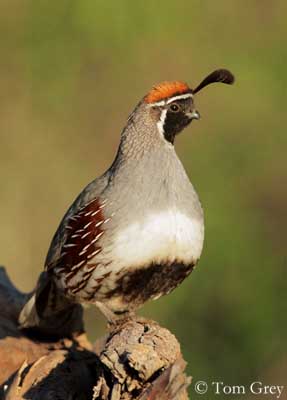
Gambel’s Quail
Callipepla gambelii
Galliforme Order – Odontophoridae Family
BIOMETRICS:
Length: 23-27 cm
Weight: M: 160g – F: 156 g
DESCRIPTION:
The name of the Gambel’s Quail comes from the naturalist and explorer William Gambel who found this beautiful bird.
Adult male has blue-grey plumage overall, with reddish-brown and white streaks on flanks.
On the underparts, the upper belly and the undertail-coverts are buffy-white. We can see a conspicuous black patch on the lower belly.

On the head, forehead, face, chin and throat are black, bordered by white stripe. The crown is bright chestnut and shows a prominent black teardrop-shaped single or double plume. The nape, the rear neck and the neck sides are pale grey with fine scaled effect due to faint dark grey edges to feathers.
The short, strong bill is black. Eyes are dark brown. Legs and feet are grey.
Female is slightly different and browner than male. Head and throat are greyish with fine dark streaks. She has shorter crest. The black patch of the belly is absent.
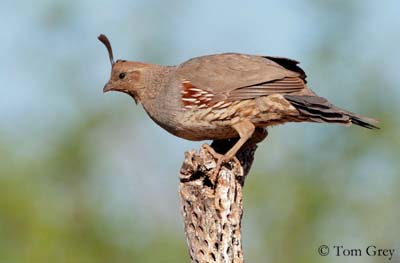
The juvenile has cryptic colours on the upperparts mixed with pale grey-brown, white and blackish. Flanks are duller and lack the adult pattern.
We can find 7 subspecies which differ on tone of grey on the upperparts and of buff on belly.
VOICE: SOUNDS BY XENO-CANTO
The Gambel’s Quail produces several grunts and cackles “ka-ka-ka” and loud “ka-kya, ka-kya, ka”. It also gives a plaintive “qua-el” and a single crowing “ka-owh”, and also more liquid chattering calls.
The notes are usually higher-pitched than in California Quail.
The male often calls from exposed perch.
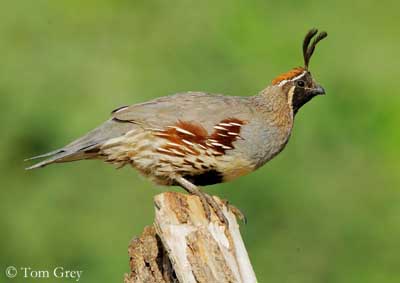
HABITAT:
The Gambel’s Quail frequents arid desert scrub and brushy riparian woodlands. It can be found in varied types of desert from low warm desert valleys with mesquite (Prosopis) or upland warm deserts with Acacia, yuccas and cactus, to cool desert with sagebrush (Artemisia).
It also frequents cultivated areas. It is usually found near permanent water source.
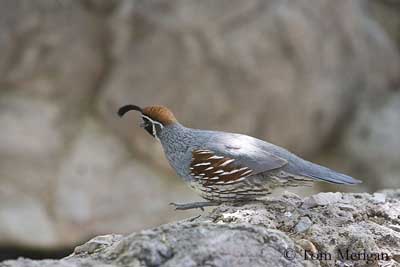
RANGE:
The Gambel’s Quail is sedentary in the desert regions of SW United States, in Arizona, California, Colorado, New Mexico, Nevada, Utah, Texas and Sonora.
The species has been introduced to the Hawaiian Islands.
BEHAVIOUR:
The Gambel’s Quail prefers the vegetables and feeds mainly on flowers, fruits and seeds from several plant species, including Fabaceae (Lotus corniculatus), Filaree (Erodium cicutarium), Alfalfa (Medicago sativa) and mesquites (genus Prosopis). It feeds on flowers and sweet fruits of the Saguaro, which are an important food source for the species living in arid areas.
If its favoured plants are nor available, it needs to drink water regularly. It also consumes some insects.
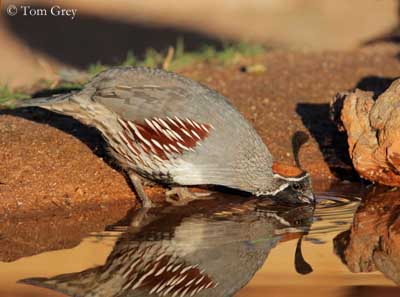
The Gambel’s Quail is gregarious and forms large coveys (12-40 birds) in autumn and winter. This species may sometimes hybridize with the Scaled Quail and the California Quail when their ranges overlap.
When alarmed, they prefer to hide and crouch in the vegetation, rather than take off. If the flock is flushed, the birds fly off in all directions.
They spend most of their time on the ground, as well for feeding by day, as for roosting and sleeping at night.
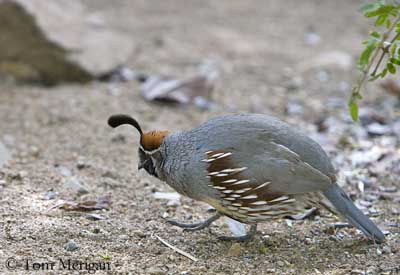
During the breeding season, the Gambel’s Quail seems to be monogamous. Their courtship displays are those of numerous Galliforme species, with frontal and lateral postures by males. During these displays, the teardrop-shaped plume, the head and body patterns play an important role, and the wings are often spread or dropped. These postures are accompanied by sounds.
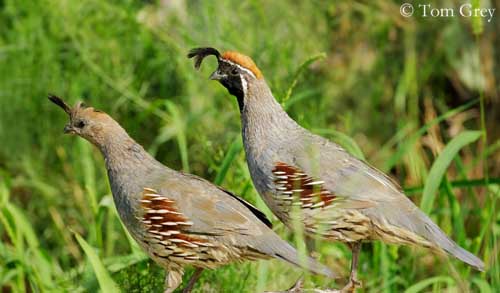
The Gambel’s Quail is sedentary with short movements, only over some kilometres.
FLIGHT:
The Gambel’s Quail prefers to run rather than fly when disturbed. However, this bird is a powerful flier over short distances. The take off is often very steep, and then, the wing-beats are rapid and interspersed with glides. They have fairly direct flight ending in slow glide to the ground.
REPRODUCTION:
The breeding season usually occurs during the local wet season. The Gambel’s Quail breeds between late April and August.
The nest is on the ground, a shallow depression concealed among the vegetation and lined with grasses, stems and feathers.
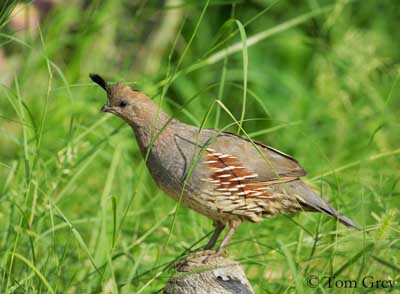
The female lays 12-14 white eggs (sometimes up to 19) with dark markings. She incubates during about 23 days. Both parents rear the chicks which are precocial and leave the nest, guarded by one or both adults.
This species can produce one or two broods per season.
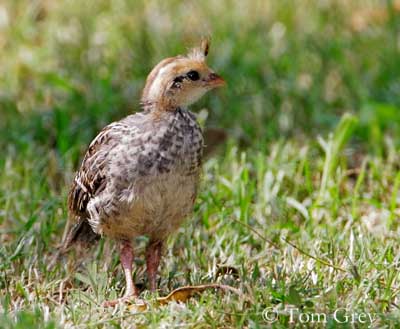
DIET:
The Gambel’s Quail feeds mainly on flowers, fruits and seeds from several plant species, but the main food source is the Saguaro cactus which provides them food and water.
Some insects are eaten by the chicks.
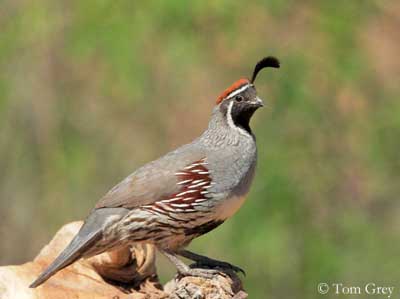
PROTECTION / THREATS / STATUS:
The populations of the Gambel’s Quail are safe, but the overgrazing and the hunting pressure can reduce them. They also are preyed upon by both aerial and terrestrial predators.
This species has adapted to the conversion of desert to cultivated areas, and is not threatened at this moment.
Fr: Colin de Gambel
All : Helmwachtel
Esp : Colín de Gambel
Ital : Colino di Gambel
Nd : Helmkwartel
Sd : Ökentofsvaktel
Photographers:
Tom Grey
Tom Grey's Bird Pictures
Tom Merigan
Tom Merigan’s Photo Galleries
Pete Moulton
Pete Moulton Photography
Text by Nicole Bouglouan
Sources:
HANDBOOK OF THE BIRDS OF THE WORLD Vol 2 by Josep del Hoyo-Andrew Elliot-Jordi Sargatal - Lynx Edicions - ISBN: 8487334156
A GUIDE TO THE BIRDS OF MEXICO AND NORTHERN CENTRAL AMERICA by Steve N. G. Howell, Sophie Webb - Oxford University Press - ISBN: 0198540124
FIELD GUIDE TO THE BIRDS OF NORTH AMERICA - National Geographic Society - ISBN: 0792274512
Animal Diversity Web (University of Michigan Museum of Zoology)
What Bird-The ultimate Bird Guide (Mitchell Waite)
Wikipedia (Wikipedia, The Free Encyclopedia)